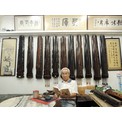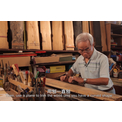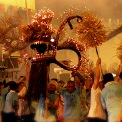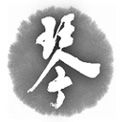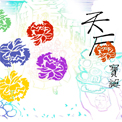 Collections
Collections The Oral Legacies (I) - Intangible Cultural Heritage of Hong Kong
The Oral Legacies (I) - Intangible Cultural Heritage of Hong Kong The Arts of the Guqin (The Craft of Qin Making)
The Arts of the Guqin (The Craft of Qin Making) Forerunners in Qin Making in Hong Kong
Forerunners in Qin Making in Hong Kong
The guqin, also known as qin, has a history that dates back to more than three millennia ago and is one of the earliest plucked-string instruments of China. It is the first of the four arts in Chinese culture: qin, qi (chess), shu (calligraphy) and hua (painting). The “art of guqin music” was designated a Masterpiece of the Oral and Intangible Heritage of Humanity (currently the Representative List of the Intangible Cultural Heritage of Humanity) by UNESCO in 2003.
Qin making is a craft that starts with chopping and trimming a piece of wood, and involves carpentry, lacquering, tuning of strings, inlay work, calligraphy and engraving, until it reaches the final stage of becoming an instrument. Fine craftsmanship leads to a fine instrument, and qin players have a historical tradition of crafting their own.
During the tumultuous times of the 1940s and 1950s, many scholars and the literati from the Mainland China came to Hong Kong. It was these new immigrants who helped to start the legacy of qin music in the local community. They would hold gatherings in which they played music, thus perpetuating the lineage in Hong Kong during the relatively stable political period of the 1950s and 60s. Among the first arrivals were Xu Wenjing, Tsar Teh-yun, Yung Sum-yin, Yung Sze-chak, Lu Jiabing and others, with Xu, a native of Zhejiang, being the most significant figure in bringing the art of qin making to Hong Kong.
Xu learned how to play and make qin first from his elder brother, Xu Yuanbai, and then from his brother’s teacher, the Buddhist monk of Tianpingshan in Suzhou, Daxiu. On resettling in Hong Kong, he passed on the qin making techniques to Choi Chang-sau in the late 1950s, thus establishing the Xu lineage in Hong Kong. Choi Chang-sau is a native of Chaozhou. His grandfather, Choi Chun-fook, and his father, Choi Wai-king, operated a family business in musical instruments. Between the 1950s and 1960s, the Mainland was enforcing an “instrumental reform”, or remodelling of musical instruments. The traditional qin was criticised for both its form and its musical tradition. By the time of the Cultural Revolution, qin as a musical art was at its trough. But the traditional techniques of making the instrument were not lost, thanks to Choi Chang-sau in Hong Kong who continued to make and repair qins for players local and overseas.
